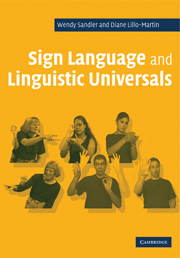25 - The effects of modality: linguistic universals and sign language universals
Published online by Cambridge University Press: 05 June 2012
Summary
Signed languages and linguistic universals
As the preceding twenty-four chapters of this book have demonstrated, languages produced by the hands and body and perceived by the eyes bear striking resemblance to the languages that are used more widely, those that are spoken and heard. A body of research that is quite large compared to its relative recency clearly proves that this is so.
The resemblances are far from trivial. While it might not be remarkable to discover that sign languages convey propositions as spoken languages do, the finding that sign languages distinguish between coordinated and recursively embedded sentences is certainly important (Chapter 18). That they allow arguments of a verb to be covert provided they are properly licensed is of similar significance (Chapter 21). That syntactic movement exists and is subject to the same constraints found in spoken languages (Chapters 20, 22, 23) provides strong evidence for the universality of such linguistic properties. Aspects of syntactic structure such as these are quite abstract, and they are fundamental to human language.
The combination of meaningful words with word partials to form more complex words may not be a particularly surprising discovery at first glance. But given that the words of sign language are often iconically motivated, this discovery becomes more interesting. And it is clearly significant that the two different types of morphology commonly found in spoken languages exist in sign languages as well (Chapters 3, 4): the morphology of syntax (inflection) and the morphology of lexeme formation (derivation).
- Type
- Chapter
- Information
- Sign Language and Linguistic Universals , pp. 477 - 510Publisher: Cambridge University PressPrint publication year: 2006
- 2
- Cited by



